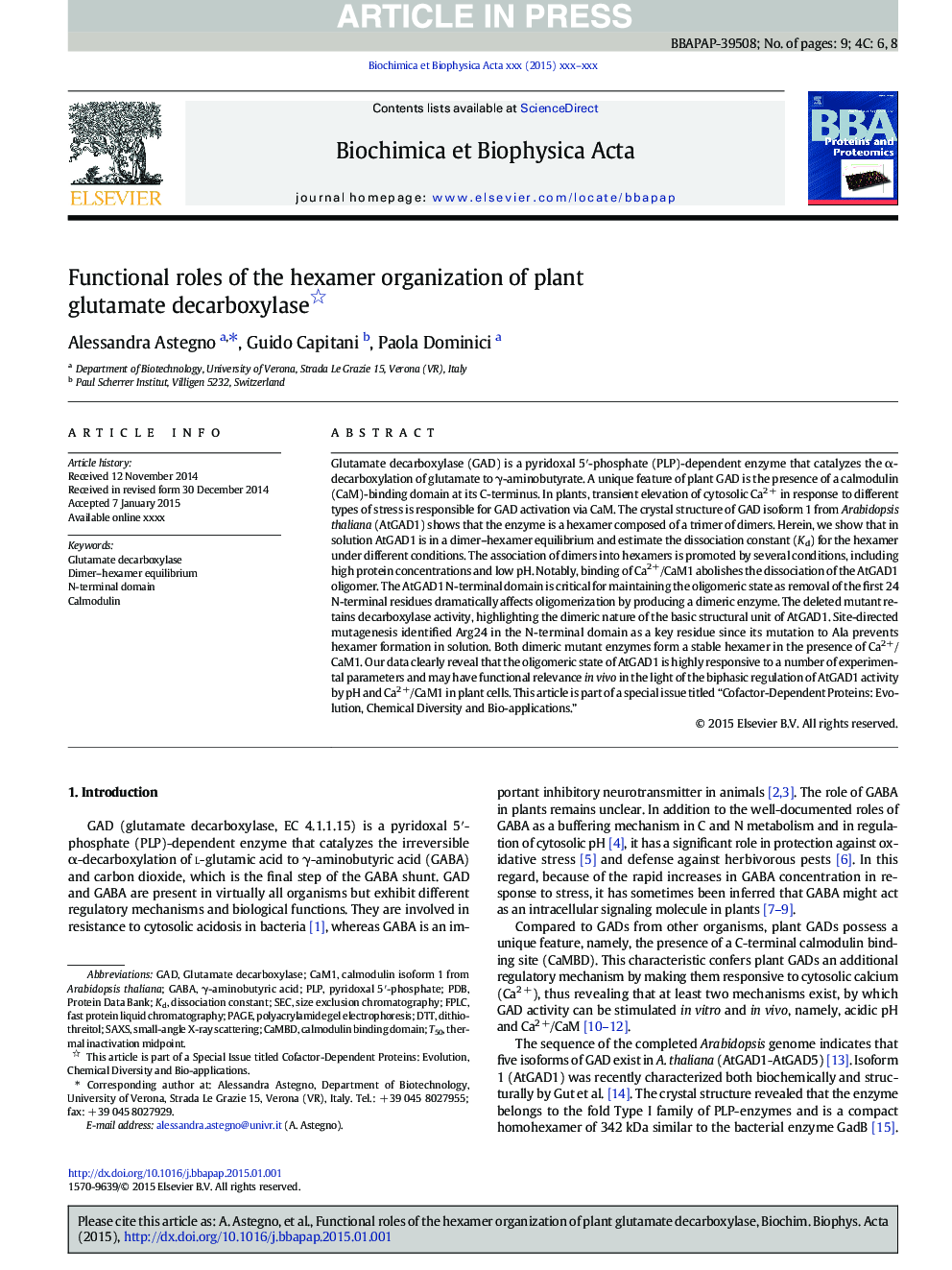| کد مقاله | کد نشریه | سال انتشار | مقاله انگلیسی | نسخه تمام متن |
|---|---|---|---|---|
| 10537137 | 962683 | 2015 | 9 صفحه PDF | دانلود رایگان |
عنوان انگلیسی مقاله ISI
Functional roles of the hexamer organization of plant glutamate decarboxylase
ترجمه فارسی عنوان
نقش های کارکردی سازمان هگزامر دکربوکسیلاز گلوتامات گیاهی
دانلود مقاله + سفارش ترجمه
دانلود مقاله ISI انگلیسی
رایگان برای ایرانیان
کلمات کلیدی
FPLCSAXSCaMBDt50PLPPAGEGADPDBSECDTTγ-aminobutyric acid - اسید γ-آمینوبوتیریکpolyacrylamide gel electrophoresis - الکتروفورز ژل پلی آکریل آمیدDissociation constant - حد تفکیکN-terminal domain - دامنه N-terminalCalmodulin binding domain - دامنه اتصال کالمدولینdithiothreitol - دیتیوتریتولfast protein liquid chromatography - سریع کروماتوگرافی مایع پروتئینSmall-angle X-ray scattering - پراکندگی اشعه ایکس با زاویه کوچکProtein Data Bank - پروتئین بانک اطلاعاتیpyridoxal 5′-phosphate - پیریدوکسال 5'-فسفاتCalmodulin - کالمودولینSize exclusion chromatography - کروماتوگرافی اندازهای طردیGABA - گاباGlutamate decarboxylase - گلوتامات دکربوکسیلاز
موضوعات مرتبط
مهندسی و علوم پایه
شیمی
شیمی آنالیزی یا شیمی تجزیه
چکیده انگلیسی
Glutamate decarboxylase (GAD) is a pyridoxal 5â²-phosphate (PLP)-dependent enzyme that catalyzes the α-decarboxylation of glutamate to γ-aminobutyrate. A unique feature of plant GAD is the presence of a calmodulin (CaM)-binding domain at its C-terminus. In plants, transient elevation of cytosolic Ca2 + in response to different types of stress is responsible for GAD activation via CaM. The crystal structure of GAD isoform 1 from Arabidopsis thaliana (AtGAD1) shows that the enzyme is a hexamer composed of a trimer of dimers. Herein, we show that in solution AtGAD1 is in a dimer-hexamer equilibrium and estimate the dissociation constant (Kd) for the hexamer under different conditions. The association of dimers into hexamers is promoted by several conditions, including high protein concentrations and low pH. Notably, binding of Ca2 +/CaM1 abolishes the dissociation of the AtGAD1 oligomer. The AtGAD1 N-terminal domain is critical for maintaining the oligomeric state as removal of the first 24 N-terminal residues dramatically affects oligomerization by producing a dimeric enzyme. The deleted mutant retains decarboxylase activity, highlighting the dimeric nature of the basic structural unit of AtGAD1. Site-directed mutagenesis identified Arg24 in the N-terminal domain as a key residue since its mutation to Ala prevents hexamer formation in solution. Both dimeric mutant enzymes form a stable hexamer in the presence of Ca2 +/CaM1. Our data clearly reveal that the oligomeric state of AtGAD1 is highly responsive to a number of experimental parameters and may have functional relevance in vivo in the light of the biphasic regulation of AtGAD1 activity by pH and Ca2 +/CaM1 in plant cells. This article is part of a special issue titled “Cofactor-Dependent Proteins: Evolution, Chemical Diversity and Bio-applications.”
ناشر
Database: Elsevier - ScienceDirect (ساینس دایرکت)
Journal: Biochimica et Biophysica Acta (BBA) - Proteins and Proteomics - Volume 1854, Issue 9, September 2015, Pages 1229-1237
Journal: Biochimica et Biophysica Acta (BBA) - Proteins and Proteomics - Volume 1854, Issue 9, September 2015, Pages 1229-1237
نویسندگان
Alessandra Astegno, Guido Capitani, Paola Dominici,
